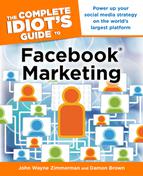Sell Products on Facebook
When it comes to selling your products or services on Facebook, the most important thing to remember is that it isn’t an online marketplace like Amazon.com, which is built from the ground up for commerce. People go onto Amazon to buy, but they go onto Facebook to connect. After they connect with you, you can discuss a sale. Up to this point in the book, we’ve focused on making the connection. Now it’s time to start thinking about the actual sale.
So how do you get the sale on Facebook? It comes down to the following major decisions:
• When to be direct and when to be discreet
• Knowing when to ask for the sale
• Deciding between Facebook sales tools and third-party software
Let’s take a look at these choices.
Marketing Transparency
Facebook has brought interesting sales terms into the forefront, one of them being marketing transparency. You may recall from Chapter 2 that marketing transparency involves a business giving a customer an incentive to buy without actually engaging in the hard sell. Because Facebook is a social medium, it gives us a greater opportunity to connect with our audiences and give them something more than just a quick sale. Ideally, marketing transparency builds a relationship with the client that leads to multiple sales down the line.
Here’s how marketing transparency works:
• You create a free or low-cost service to the public.
• You help the client discover why he or she needs the service.
• You mention a discount for the service or a product in exchange for a longer-term commitment.
For example, let’s say you’re a restaurant owner planning to launch a happy hour. It’s easy to advertise “Half-off drinks!” just like every other liquor-licensed establishment in your city, but you want to build a relationship with your new customers.
Instead of focusing on happy hour, you can give the customers more bang for their buck. As an example, if you want the jazz crowd, you could have a music trio come in occasionally for happy hour. Your advertisements, whether on Facebook, in the newspaper, or on a flyer, would advertise the free entertainment along with the happy hour prices.
| FRIENDLY ADVICE |
Make sure your promotion is targeted toward the audience you want. For instance, if you want to get your high-end restaurant known among the upper crust of society, you probably don’t want to do an open mic night, but you could feature a local painter’s “tasteful” work on your Wall and have a party celebrating the exhibit on opening night.
After a few weeks of happy hours, you can monetize your audience and advertise your restaurant in many ways, including the following:
• Create a lunch discount: Attend three happy hours and you get a free side order at lunch. Advertise the special discount through your Facebook page.
• Raise the happy hour prices: Ultra-low happy hour prices can be a loss leader for more profitable happy hour prices later. By then, the audience will be coming for the free music and won’t mind paying a little extra. If people question the pricing, you can say you’d like to give extra to the great band.
One successful example is Leland Tea Company, a small, but busy café in San Francisco. A couple years ago the owner began hosting Iron Cupcake, a play on the popular television show Iron Chef, where bakers are given a mystery ingredient and they have to make the best cupcake featuring it. The ingredients vary from chocolate to curry, bringing heavy discussions on the Leland Tea Company Facebook page and curious new customers to the little tea house for the free monthly event.
They even created a serious buzz and brought in people who later became regular customers.
The Direct Approach
Alternatively, it’s sometimes best not to beat around the bush. Yes, we’re big fans of marketing transparency, but the direct marketing approach can truly highlight the best parts of your business, including:
• Your business’s personality
• Your business’s service or product
• Your customer timeline
For example, if you own a garage, your customer is going to think of you only when he needs his car repaired. When you first meet, the customer is likely going to be in the midst of a crisis and isn’t going to be interested in building a relationship.
As a result, your Facebook marketing needs to be more direct than, say, a growing church or a budding department store. For instance, the garage could give priority service to customers who Like its Facebook page. Or customers who check in to the business on Facebook (we discuss check-ins in Chapter 18) get a free car inspection.
When to Ask for the Sale
The best time to ask for a sale is when the client is engaged. To get a client engaged takes time. In other words, getting to the right sale time takes patience.
Remember that people come to Facebook to communicate. It could take several discussions and maybe even some freebies on your part to get a customer, not to mention a loyal customer.
